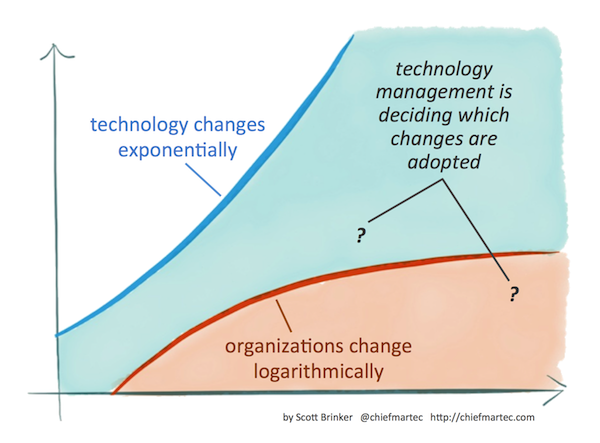
I believe these two things are true:
- Technology is changing very rapidly, and those changes seem to be accelerating.
- Changing an organization — how it thinks and behaves — is still hard and slow.
These two truths are at the core of this blog’s mission: helping marketers understand how marketing technology is changing and how they can successfully adapt their organizations to those changes. But I’ve struggled to find a concise way to visualize the interplay between those two dynamics.
Yesterday, I had an epiphany and sketched the graph at the top of this post.
Consider the Y-axis to be “quantity of change” and the X-axis to be time.
Technology advances exponentially — the sharply rising blue curve on top. This is a generally accepted phenomenon. Moore’s Law is the exponential growth of computing power. Metcalfe’s Law is the exponential value of interconnections on expanding networks. (See the 7 laws of technology for marketers for an explanation of those laws.) The futurist Ray Kurzweil has identified this exponential technological progress on many fronts as part of a law of accelerating returns.
Of course, some kinds of technological change are harder to quantity. For instance, how should we measure how fast social media is changing? But I think we all feel the incredible velocity of technological change in our lives, and we would characterize it as something faster than steady, linear growth.
But organizations absorb changes logarithmically — the much slower rising red curve below it. It takes time for people to alter their thinking and their behavior. With groups of people, where there are existing structures, processes, incentives, and cultural momentum, it takes even more effort to turn the ship. The larger the group, the greater the institutional resistance.
Admittedly, this logarithmic limit to organizational change isn’t a well-known law — at least not one that I know of. But based on my experience, that’s a pretty close approximation. And although I haven’t seen a mathematical equation for that limit, there have been hundreds of best-selling books written on the difficulties of personal and organizational change. Empirically, the limit of change for humans is less than linear.
I’d also emphasize that this is a limit. In other words, it’s not feasible for an organization to change faster than that. But it’s certainly possible for an organization to change more slowly — or not at all. In fact, in the absence of good leadership, stagnation seems like the default outcome. But even with great leadership, an organization can’t win by outracing technology. It needs a more nuanced strategy.
The great management dilemma of the 21st century is the relationship between these two curves: technology is changing faster than organizations can absorb change.
In A.G. Lafley’s book, Playing to Win: How Strategy Really Works, he drives home the point that strategy is choice. It’s decisively choosing to do certain things and to not do others. Great strategies provide an unequivocal guide to deciding what’s in or out, rather than timidly trying to do everything half-baked.
That is the crux of technology management. We can’t adopt all technological changes, but we can consciously choose some. Great technology management is choosing which changes to absorb — ideally those that are best aligned with the organization’s overall strategy.
In the graph, it’s intentionally deciding what’s in (the red shaded area) and what’s out (the blue shaded area).
We also need to recognize how entwined organizational change is in technology strategy. It’s not enough to decide which technological changes to embrace or to deal with the technical implementations of those choices. To succeed, technology management must explicitly address how those technologies will be absorbed into the operations and the culture of the organization. It must proactively coach, coax, nurture, educate, train, elevate, and inspire the people who will wield that technology.
In no context is this more true than marketing and marketing technology.
Of course, it’s true in other disciplines too. And someone else may have already made this exact observation — no doubt someone will inform me of my lack of originality in the comments below. But if this is a novel way of framing this challenge, then in honor of the marketing technologists who wrestle with this dynamic every day, I’d propose calling it Martec’s Law:
Martec’s Law:
Technology changes exponentially;
organizations change logarithmically.
What do you think?



